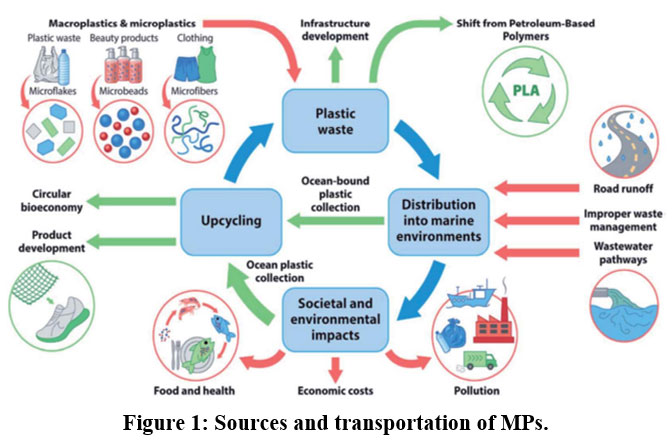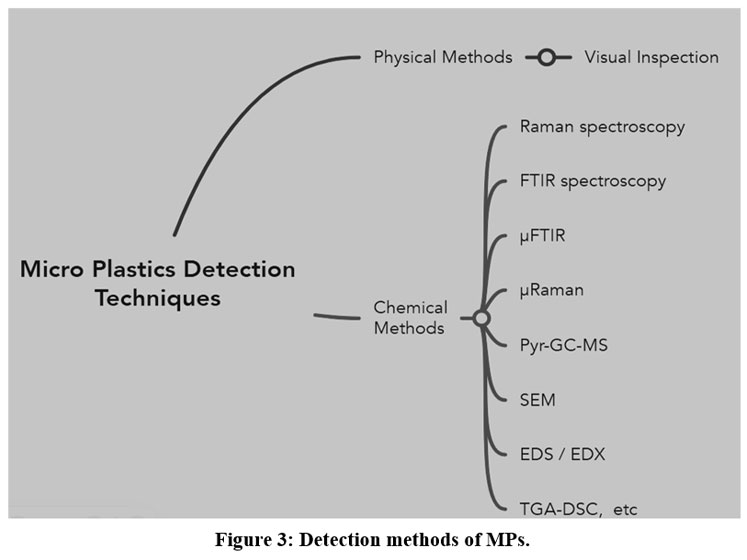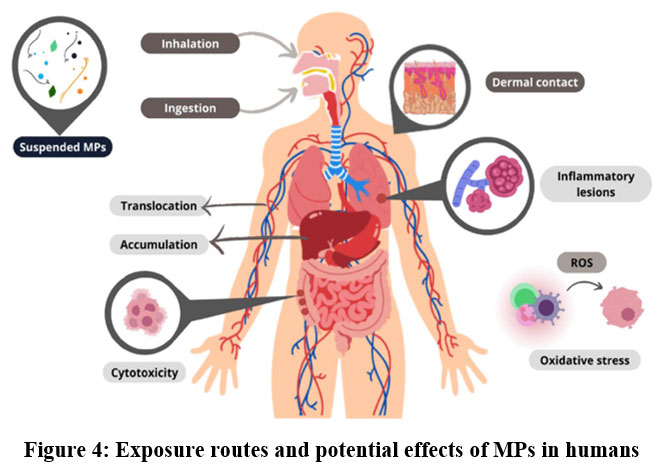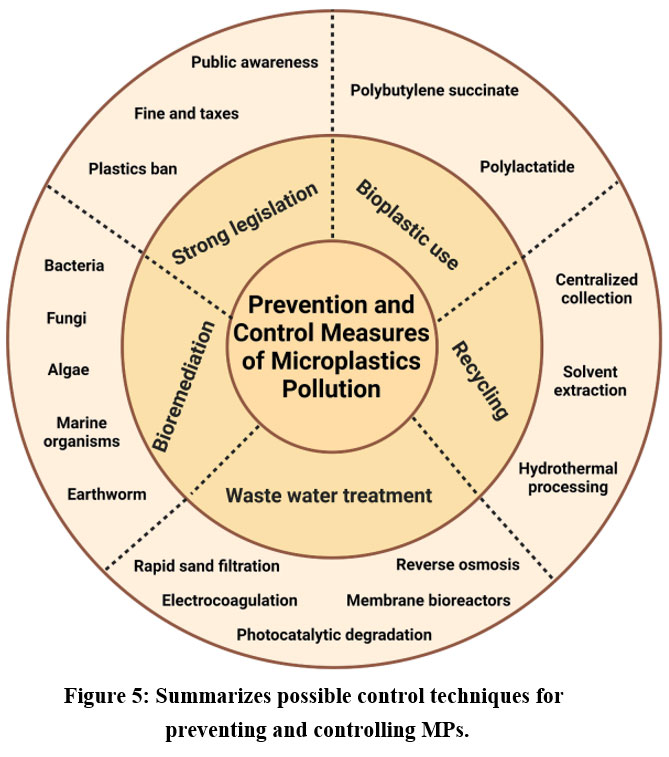Microplastics and Environment: A mini Review on Detection, Removal, Health Issues and Regulation on India’s Perspective
1
Department of Chemistry,
Charuchandra College, under University of Calcutta,
Lake Road, Kolkata,
West Bengal
India
Corresponding author Email: mominulsinan@gmail.com
DOI: http://dx.doi.org/10.12944/CWE.19.2.2
Copy the following to cite this article:
Sinan M. Microplastics and Environment: A mini Review on Detection, Removal, Health Issues and Regulation on India’s Perspective. Curr World Environ 2024;19(2). DOI:http://dx.doi.org/10.12944/CWE.19.2.2
Copy the following to cite this URL:
Sinan M. Microplastics and Environment: A mini Review on Detection, Removal, Health Issues and Regulation on India’s Perspective. Curr World Environ 2024;19(2).
Download article (pdf)
Citation Manager
Publish History
Select type of program for download
| Endnote EndNote format (Mac & Win) | |
| Reference Manager Ris format (Win only) | |
| Procite Ris format (Win only) | |
| Medlars Format | |
| RefWorks Format RefWorks format (Mac & Win) | |
| BibTex Format BibTex format (Mac & Win) |
Article Publishing History
| Received: | 2024-07-03 |
|---|---|
| Accepted: | 2024-09-03 |
| Reviewed by: | 
 Ephsy Davis
Ephsy Davis
|
| Second Review by: |

 Sunil Sable
Sunil Sable
|
| Final Approval by: | Dr. R K Aggarwal |
Introduction
The global demand for plastics1 has increased exponentially due to its flexibility, mechanical strength, lightweight, and affordability. Plastics are integrated into our day-to-day lives. It has been widely used in utensils, packaging materials, the automobile industry, electronic appliances2, construction3, furniture4, sports equipment5, and more. Globally plastics production has increased tremendously and by 20506 the production is projected to stretch per year by 34 billion metric tons. In recent decades7 remarkable rise in the extent of single-use plastic waste has been noted and only around 20% of plastics only recycled for further use. Plastics that enter the environment slowly break down into micro- and nano-particles8 under the influence of constant external forces like wave washing, UV radiation9, weathering, biodegradation10, aerial oxidation11, etc.
It is an increasing contaminant that has raised a lot of concern in the community. MPs have the potential to move through various environmental media12 and can be found in soil, air, and water13. The majority of MPs in the atmosphere are carried by wind, and they can deposit by both wet and dry media on soil and water. Recently, a number of research on the origins of MPs and the analytical techniques required for detection14 have been conducted. MPs mostly enter in the human body through the skin, food, and respiratory systems. MPs have the potential to be consumed and stored by organisms15, impacting the ability to survive, grow, immunity system and reproductively etc. Human health16 is significantly harmed by MPs. This review's primary goal is to shed light on the incidence, identification, elimination, and toxicological effects of MPs in a nutshell.
What is Microplastics (MPs)
The term "microplastics" was first used by Thompson et al.17 in 2004. MPs are plastic pieces that are smaller than 5 millimeters in size18. Natural polymers such as rubber and cellulose can also be categorized as MPs, in addition to synthetic ones. MPs are utilized in the manufacturing sectors19 and in the process of 3D printing. They can be found in everyday items like synthetic clothing material, toothpaste, and beauty products etc. These microbeads are also created when plastics disintegrate into small particles. MPs come in various colours, compositions, sizes, and shapes20.
In accordance with sources, MPs are classified into primary MPs and secondary MPs. Plastics that are directly produced in the course of production and finally released into the environment are referred to as primary MPs. Personal care products, medical products, wastewater, and water-based coatings21 are the main sources of primary MPs. Secondary MPs are characterized as broken pieces of bigger plastic objects that are prevalent in both terrestrial and marine environments and suffer from fragmentation. Figure 122 shows the sources and transport of MPs. Large plastic also breaks down into little fragments23 due to weathering. Oxidative photodegradation process24 also breaks down the polymer and forms MPs. Figure 2 shows the main categories of microplastics25.
 | Figure 1: Sources and transportation of MPs.
|
 | Figure 2: Main categories of MPs.
|
Detection techniques
Due to inadequate waste management systems in developing countries, the majority of plastic garbage is dumped in vacant landfills. When embedded plastics get the exposure of sunlight, bacteria, aerial oxygen, and mechanical stress they degrade into MPs26. Detection and quantification techniques for MPs are yet to be standardised. However, available approaches are often divided into two categories: physical and chemical procedures.
MPs can be identified by a physical method using visual inspection or by microscopy due to their unique physical properties. Though this method has several advantages, such as the fact that it does not require a trained analyst, costly apparatus, or poisonous reagents, this method is not precise as soon as the particle size decreases to below 500 µm27.
Common methods for the characterization of MPs incorporate chemical methods, in this method, more precise results can be obtained. Raman spectroscopy, FTIR spectroscopy along with µFTIR or µRaman are used for the distinguishing proof of MPs. Pyrolysis-gas chromatography/mass spectrometry (Pyr-GC-MS)28 is also very popular for the detection. Another strategy to examine the recognizable proof of MPs is scanning electron microscopy (SEM). In SEM morphological information can be obtained from the pictures usually taken in high-resolution. Furthermore, SEM along with energy-dispersive X-ray spectroscopy (EDS29 or EDX) provides a high-pitched image. Novel strategies too created for the detection such as thermogravimetry and differential scanning calorimetry (TGA-DSC), desorption, thermal extraction, gas chromatography, and mass spectrometry30. The integration of several approaches can complement one another and help to overcome the obstacles associated with the recognition of MPs31. Figure 3 summaries the different detection methods for MPs.
 | Figure 3: Detection methods of MPs.
|
Removal techniques
It is important to isolate and remove MPs. The physical nature like shape and the chemical nature of MPs, including size, texture, density, and other sediments could affect the separation process. Several techniques have been developed over the years. These techniques in general are categorized into physical, chemical, and biological methods. Every technique has both advantages and disadvantages also. Here the latest solutions of some of the techniques are mentioned below.
The physical methods to remove particulate matter and toxins include conventional activated sludge process (CAS)32, Rapid sand filtration (RSF)33, Dissolved air flotation (DAF)34, microfiltration (MF), Disc filter (DF)35, Dynamic membrane (DM)36, Magnetic nanoparticle method35 and ultrafiltration36.
In addition to physical methods numerous chemical methods are also available, which include electrocoagulation37, photocatalysis38, Micromotors39, and Microsubmarines40. Separation by chemical methods are generally done by adding definite chemicals to interact with the polymer particles and followed by flocs formation, these flocs need to be collected afterwards41. Research is currently going on to optimize parameters for the effective removal of MPs. The parameters under consideration are the proper types of coagulant, the right dosage, and interaction time42. By biological methods of removal, microorganisms are added to disintegrate organic matter and MPs by aerobic and anaerobic processes. Recent research43 suggests that aerobic processes are advantageous over anaerobic processes. Results show that microorganisms can remove MPs through enzymatic activities44. Bioremediation techniques have the potential to control the MP’s pollution45 in a sustainable way.
Human health issue
There are three main established46 routes unambiguously consumption, breathing, and dermal contact through which MPs are incorporated to humans47 as shown in Figure 4. In spite of the fact that the documented proof of MP’s contamination in the environment and food web is already established, but their intake and movement within the body system remain questionable for a long time48. Therefore, all results should be considered to be suggestive.
These will guide studies aimed at assessing the toxicity of particles at levels relevant to humans. Accumulation of data49 shows that MPs of significant size can penetrate deep into human anatomical structures. The presence of MPs in different human tissues has been reported. MPs have been shown to induce toxicity by causing oxidative stress50 and the formation of lipid peroxide which indirectly causes DNA damage product. MPs can also affect the immune system51 by altering the cytokines production levels, which in the long run may be a cause of cancer. Chronic exposure52 to MPs through food can lead to intestinal damage, cell necrosis, changes in the metabolism of fat, and a decrease in energy reserves. Exposure to MPs might also cause neurotoxicity and have endocrine-disrupting effects leading to infertility.
 | Figure 4: Exposure routes and potential effects of MPs in humans
|
Regulation
Available reports have convincingly demonstrated the negative impacts of MPs on living creatures, indicating the need for global control over MPs pollution. To overcome these issues, an integrative approach is encouraged, which includes source control and the concepts of reduce, reuse, recycle, recover, and replace53. Plastic waste generation must be controlled by legislation and adequate monitoring, single-use plastic items should be reduced, and more attention should be placed on the transition to plastic alternatives. It is advised that conventional petroleum-based plastics be replaced with more environmentally friendly bioplastics54.
Some countries have implemented stringent rules and legislation to reduce plastic mess generation. To address this issue, public awareness efforts are important. A centralized recycling facility with the active participation of people can minimise plastic pollution. The primary source of MPs is typically linked to wastewater treatment facilities; thus, eliminating MPs from water effluents with modern water treatment technology can significantly reduce plastic pollution. A combination of traditional methods with modern approaches can remove MPs to a greater extent55. Figure 5 Summarizes possible control techniques52 for preventing and controlling MPs.
 | Figure 5: Summarizes possible control techniques for preventing and controlling MPs.
|
Regulation in India
India is one of the 12 countries responsible for more than 50% of the world’s mismanaged plastic waste56. India recycles only 8% of its plastic waste57. There aren't many recycling and landfilling facilities in India, and many of them are poorly run. Because of this, it is challenging to gather and properly dispose of plastic waste without harming the environment. India’s Plastic Waste Management Rule has been amended58 different times to decrease the pollution caused by plastics. The nationwide ban on single-use plastic bags has been implemented since 2016, but it has yet to be fully enforced due to a lack of awareness and insufficient adherence to regulations. Thus banned items are still easily available in the market. United Nations Development Programme (UNDP) India59, in partnership with Hindustan Coca-Cola Beverages Private Limited (HCCBPL), Hindustan Unilever Limited (HUL), HDFC Bank and Coca-Cola India Foundation (CCIF) is encouraging assembling, separation, and recycling plastics to move towards a circular economy. As UN member states India is committed to ‘End Plastic Pollution’ by 2024. Recently the Ministry of Environment, Forest and Climate Change has implemented amendments in Plastic Waste Management Rules, 2016, by the Plastic Waste Management (Amendment) Rules60, 2024 targeting MPs and setting stricter criteria for biodegradable plastics.
Recently, on August 18, 2024, the Food Safety and Standards Authority of India (FSSAI) launched61 a project with the collaboration of different research institutes like CSIR-IITR, ICAR-CIFT, and BITS-Pilani to collect data on MPs exposure levels as well as to develop standard techniques for micro/nano-plastic analysis. Every stakeholder has to work unitedly to address the problems.
Challenges
It is critical to prioritize improvements in MPs sampling, detection, and removal technologies. A uniform approach for the testing, assessment and characterisation of MPs is critically needed. It is essential to plan new MP detection techniques that are easy, quick, and inexpensive. Interdisciplinary approach will give a complete view of MPs impacts. More focus is needed on the regulation of plastic waste management and plastic production processes. Moreover, the plastic pollution does not terminate with MPs because these MPs might further fracture and form nano-plastics, which are even smaller in size and so their collections, detections, movements and interactions with the surroundings are unknown are more complex.
Conclusion
This article provides comprehensive information on MPs as an emerging environmental pollutants. Primary MPs and secondary MPs influence the overall number of MPs available in the surroundings. The development in uniform standard procedure for the estimation of MPs is the important task. Available analytical methods for detection and estimation have their own merits and demerits, so improvements in test methods will provide more focused and comprehensive knowledge about MPs.
Future research should focus on a comprehensive assessment of the hazards connected with MPs exposure, more particulars on their mechanism and their associative activity with other organic molecules as well as heavy metals. Furthermore, the creation of operative guidelines, encouraging public awareness about reduce, reuse, recycling and the use of materials alternatives to plastics with worldwide cooperation to limit MPs pollution.
Acknowledgement
I am thankful to my departmental colleague for their constructive suggestions during the manuscript preparation.
Funding sources
The author received no financial support for the research, authorship, and/or publication of this article.
Conflict of Interest
The authors do not have any conflict of interest.
Data Availability statement
The manuscript incorporates all datasets produced or examined throughout this research study
Ethics Statement
This research did not involve human participants, animal subjects, or any material that requires ethical approval.”
References
- https://plasticseurope.org/wp-content/uploads/2021/10/2017-Plastics-the-facts.pdf. Accessed on 02.07.2024
- Jia C., Das P., Kim I., Yoon Y. J., Tay C. Y., Lee J. M. Applications, treatments, and reuse of plastics from electrical and electronic equipment, J. Ind. Eng. Chem. 2022; 110:84-99.
- Li L., Zuo J., Duan X., Wang S., Chang R. Converting waste plastics into construction applications: A business perspective, Environ. Impact Assess. Rev. 2022; 96:106814.
- Ahmad F., Ahmad A., Saharudin H., Khairi H. A Conceptual Framework of Designer Responses in Designing Furniture Application from Upcycled Plastic Materials, Environment-Behaviour Proceedings Journal. 2020; 5(SI3):49–53.
- Suzuki G., Uchida N., Tanaka K., Matsukami H., Kunisue T., Takahashi S., Viet P.H., Kuramochi H., Osako M. Mechanical recycling of plastic waste as a point source of microplastic pollution. Environmental Pollution. 2022; 15(303):119114.
- Geyer R. Production, use, and fate of synthetic polymers. In Plastic waste and recycling 2020 Jan 1 (pp. 13-32). Academic Press.
- (a) Lebreton L., Andrady A. Future scenarios of global plastic waste generation and disposal. Palgrave Communications. 2019; 5(1):1-11. (b) Rochman C. M., Hoellein T. The global odyssey of plastic pollution. Science. 2020; 368(6496):1184–1185.
- (a) Lambert S., Wagner, M. Characterisation of nanoplastics during the degradation of polystyrene. Chemosphere. 2015; 145:265–268. (b) Song Y. K., Hong S. H., Jang M., Han G. M., Jung S. W., Shim W. J. Combined effects of UV exposure duration and mechanical abrasion on microplastic fragmentation by polymer type. Environ Sci Technol. 2017; 51(8):4368–4376. (c) Wilkinson J., Hooda P. S., Barker J., Barton S., Swinden J. Occurrence, fate and transformation of emerging contaminants in water: an overarching review of the field. Environ Pollut. 2017; 231:954–970. (d) Yousif E., Haddad R. Photodegradation and photostabilization of polymers, especially polystyrene: review. Springerplus 2013; 2:1-32.
- Sun J., Zheng H., Xiang H., Fan J., Jiang H. The surface degradation and release of microplastics from plastic films studied by UV radiation and mechanical abrasion. Science of the Total Environment. 2022; 838:156369.
- Bahl S., Dolma J., Singh J. J., Sehgal S. Biodegradation of plastics: A state of the art review. Materials Today: Proceedings. 2021; 39:31-34.
- Zhang J. L., Diao X. P. Migration and transformation of airborne microplastics. In Comprehensive Analytical Chemistry 2023 Jan 1 (Vol. 100, pp. 63-95). Elsevier.
- (a) Gong J., Xie P. Research progress in sources, analytical methods, eco-environmental effects, and control measures of microplastics, Chemosphere. 2020; 254:126790. (b) Long X., Fu T., Yang X., Tang Y. Y., Zheng Y., Zhu L., Shen H. Z., Ye J. H., Wang C., Wang T., Li, B. J. Efficient Atmospheric Transport of Microplastics over Asia and Adjacent Oceans. Environ. Sci. Technol. 2020; 56(10):6243–6252.
- Priya A. K., Jalil A. A., Dutta K., Rajendran S., Vasseghian Y., Qin J., Soto-Moscoso M. Microplastics in the environment: Recent developments in characteristic, occurrence, identification and ecological risk. Chemosphere. 2022; 298:134161.
- (a) Fahrenfeld N. L., Arbuckle-Keil G., Beni N. N., Bartelt-Hunt S. L. Source tracking microplastics in the freshwater environment. TrAC Trends in Analytical Chemistry. 2019; 112:248-254. (b) Rochman C. M. Microplastics research—from sink to source. Science. 2018; 360(6384):28-29. (c) Shim W. J., Hong S. H., Eo S. E. Identification methods in microplastic analysis: a review. Analytical methods. 2017; 9(9):1384-91.
- (a) Anderson J. C., Park B. J., Palace V. P. Microplastics in aquatic environments: implications for Canadian ecosystems. Environmental Pollution. 2016; 218:269-280. (b) Sarker A., Deepo D. M., Nandi R., Rana J., Islam S., Rahman S., Hossain M. N., Islam M. S., Baroi A., Kim J. E. A review of microplastics pollution in the soil and terrestrial ecosystems: A global and Bangladesh perspective. Science of the Total Environment. 2020; 733:139296.
- Bhuyan M. S., Venkatramanan S., Selvam S., Szabo S., Hossain M. M., Rashed-Un-Nabi M., Paramasivam C. R., Jonathan M. P., Islam M. S. Corrigendum to "Plastics in marine ecosystem: A review of their sources and pollution conduits" Regional Studies in Marine Science. 2021; 44:101658.
- Thompson R. C., Olsen Y., Mitchell R. P., Davis A., Rowland S. J., John A. W., McGonigle D., Russell A. E. Lost at sea: where is all the plastic?. Science. 2004; 304(5672):838-838.
- European Chemicals Agency, 2019. Annex XV Restriction Report, Proposal for a Restriction. Version 1.2.
- https://www.prescouter.com/inquiry/microplastics-in-industry-identifying-risks-opportunities-for-action/ Accessed on 02.07.2024
- Hale R. C., Seeley M. E., La Guardia M. J., Mai L., Zeng E. Y. A global perspective on microplastics. Journal of Geophysical Research: Oceans. 2020; 125(1): e2018JC014719
- (a) https://www.plasticseurope.org/application/files/8016/1125/2189/AF_Plastics_the_facts-WEB-2020-ING_FINAL.pdf Accessed on 02.07.2024 (b) Jeyavani J., Sibiya A., Shanthini S., Ravi C., Vijayakumar S., Rajan D. K., Vaseeharan B. A review on aquatic impacts of microplastics and its bioremediation aspects. Current Pollution Reports. 2021; 7:286-299.
- Roy P., Mohanty A. K., Misra M. Microplastics in ecosystems: their implications and mitigation pathways. Environmental Science: Advances. 2022; 1(1):9-29.
- Arthur C., Baker J., Bamford H., Proceedings of the International Research Workshop on the Occurrence, Effects and Fate of Microplastic Marine Debris, pp. 49 (NOAA Technical Memorandum NOS-OR&R-30). (2009)
- Barnes D. K., Galgani F., Thompson R. C., Barlaz M. Accumulation and fragmentation of plastic debris in global environments. Philosophical transactions of the royal society B: biological sciences. 2009; 364(1526):1985-98.
- Jin M., Liu J., Yu J., Zhou Q., Wu W., Fu L., Yin C., Fernandez C., Karimi-Maleh H. Current development and future challenges in microplastic detection techniques: A bibliometrics-based analysis and review. Science progress. 2022; 105(4):00368504221132151.
- 26. Dehghani S., Moore F., Akhbarizadeh R. Microplastic pollution in deposited urban dust, Tehran metropolis, Iran. Environmental Science and Pollution Research. 2017; 24:20360-71.
- Zhou F., Wang X., Wang G., Zuo Y. A rapid method for detecting microplastics based on fluorescence lifetime imaging technology (FLIM). Toxics. 2022; 10(3):118.
- McCormick A. R., Hoellein T. J., London M. G., Hittie J., Scott J. W., Kelly J. J. Microplastic in surface waters of urban rivers: concentration, sources, and associated bacterial assemblages. Ecosphere. 2016; 7(11):e01556.
- Park J. W., Lee S. J., Hwang D. Y., Seo S. Recent purification technologies and human health risk assessment of microplastics. Materials. 2020; 13(22):5196.
- Mansa R., Zou S. Thermogravimetric analysis of microplastics: A mini review. Environmental Advances. 2021; 5:100117.
- Zhang Z., Chen Y. Effects of microplastics on wastewater and sewage sludge treatment and their removal: a review. Chemical Engineering Journal. 2020; 382:122955.
- Lares M., Ncibi M. C., Sillanpää M., Sillanpää M. Occurrence, identification and removal of microplastic particles and fibers in conventional activated sludge process and advanced MBR technology. Water research. 2018; 133:236-246.
- Talvitie J., Mikola A., Koistinen A., Setälä O. Solutions to microplastic pollution–Removal of microplastics from wastewater effluent with advanced wastewater treatment technologies. Water research. 2017; 123:401-7.
- Zhang Z., Chen Y. Effects of microplastics on wastewater and sewage sludge treatment and their removal: a review. Chemical Engineering Journal. 2020; 382:122955.
- Simon M., Vianello A., Vollertsen J. Removal of> 10 µm microplastic particles from treated wastewater by a disc filter. Water. 2019; 11(9):1935.
- Li L., Xu G., Yu H. Dynamic membrane filtration: formation, filtration, cleaning, and applications. Chemical Engineering & Technology. 2018; 41(1):7-18.
- (a) Perren W., Wojtasik A., Cai Q. Removal of microbeads from wastewater using electrocoagulation. ACS omega. 2018; 3(3):3357-3364. (b) Miao F., Liu Y., Gao M., Yu X., Xiao P., Wang M., Wang S., Wang X. Degradation of polyvinyl chloride microplastics via an electro-Fenton-like system with a TiO2/graphite cathode. Journal of Hazardous Materials. 2020; 399:123023.
- (a) Tofa T. S., Kunjali K. L., Paul S., Dutta J. Visible light photocatalytic degradation of microplastic residues with zinc oxide nanorods. Environmental Chemistry Letters. 2019; 17:1341-6. (b) Saboor F. H., Hadian-Ghazvini S., Torkashvand M. Microplastics in aquatic environments: Recent advances in separation techniques. Periodica Polytechnica Chemical Engineering. 2022; 66(2):167-81.
- (a) Wang L., Kaeppler A., Fischer D., Simmchen J. Photocatalytic TiO2 micromotors for removal of microplastics and suspended matter. ACS applied materials & interfaces. 2019; 11(36):32937-32944. (b) Padervand M., Lichtfouse E., Robert D., Wang C. Removal of microplastics from the environment. A review. Environmental Chemistry Letters. 2020; 18(3):807-28.
- (a) Beladi-Mousavi S. M., Hermanova S., Ying Y., Plutnar J., Pumera M. A maze in plastic wastes: autonomous motile photocatalytic microrobots against microplastics. ACS applied materials & interfaces. 2021; 13(21):25102-25110 (b) Sun M., Chen W., Fan X., Tian C., Sun L., Xie H. Cooperative recyclable magnetic microsubmarines for oil and microplastics removal from water. Applied Materials Today. 2020; 20:100682.
- Badola N., Bahuguna A., Sasson Y., Chauhan J. S. Microplastics removal strategies: A step toward finding the solution. Frontiers of Environmental Science & Engineering. 2022; 16:1-8.
- Park H., Park B. Review of microplastic distribution, toxicity, analysis methods, and removal technologies. Water. 2021; 13(19):2736.
- Li Y. Technology review and selection guide for industry wastewater treatment. Computational Water, Energy, and Environmental Engineering. 2020; 9(02):22. 10.4236/cweee.2020.92003
- Harrison J. P., Sapp M., Schratzberger M., Osborn A. M. Interactions Between Microorganisms and Marine Microplastics: A Call for Research. Marine Technology Society Journal, 2011; 45(2):12.
- Meng K., Lwanga E. H., van der Zee M., Munhoz D. R., Geissen V. Fragmentation and depolymerization of microplastics in the earthworm gut: A potential for microplastic bioremediation?. Journal of Hazardous Materials. 2023; 447:130765.
- Yee M. S., Hii L. W., Looi C. K., Lim W. M., Wong S. F., Kok Y. Y., Tan B. K., Wong C. Y., Leong C. O. Impact of microplastics and nanoplastics on human health. Nanomaterials. 2021; 11(2):496.
- López A. P., Trilleras J., Arana V. A., Garcia-Alzate L. S., Grande-Tovar C. D. Atmospheric microplastics: exposure, toxicity, and detrimental health effects. RSC advances. 2023; 13(11):7468-7489.
- Ribeiro F., O'Brien J. W., Galloway T., Thomas K. V. Accumulation and fate of nano-and micro-plastics and associated contaminants in organisms. TrAC Trends in analytical chemistry. 2019; 111:139-47.
- EFSA, 2016. Presence of microplastics and nanoplastics in food, with particular focus on seafood. EFSA J. 14 (6).
- Kadac-Czapska K., O?ko J., Knez E., Grembecka M. Microplastics and Oxidative Stress—Current Problems and Prospects. Antioxidants. 2024; 13(5):579.
- Yang W., Jannatun N., Zeng Y., Liu T., Zhang G., Chen C., Li Y. Impacts of microplastics on immunity. Frontiers in toxicology. 2022; 4:956885.
- Giri S., Lamichhane G., Khadka D., Devkota H.P. Microplastics contamination in food products: Occurrence, analytical techniques and potential impacts on human health. Current Research in Biotechnology. 2024; 7:100190.
- Gupta D. K., Choudhary D., Vishwakarma A., Mudgal M., Srivastava A. K., Singh A. Microplastics in freshwater environment: occurrence, analysis, impact, control measures and challenges. International Journal of Environmental Science and Technology. 2023; 20(6):6865-96.
- Sinan M. Bioplastics for sustainable development: general scenario in India. Current World Environment. 2020; 15(1):24.
- Krishnan R. Y., Manikandan S., Subbaiya R., Karmegam N., Kim W., Govarthanan M. Recent approaches and advanced wastewater treatment technologies for mitigating emerging microplastics contamination–A critical review. Science of the Total Environment. 2023; 858:159681.
- https://www.downtoearth.org.in/news/waste/india-among-the-12-countries-responsible-for-52-of-the-world-s-mismanaged-plastic-waste-report-90927 Accessed on 02.07.2024
- https://www.theweek.in/news/india/2024/02/05/india-recycles-only-8-percent-of-its-plastic-waste-says-study.html Accessed on 02.07.2024
- https://environment.delhi.gov.in/sites/default/files/inline-files/pwm_epr_1.pdf Accessed on 02.07.2024
- https://www.undp.org/india/projects/plastic-waste-management Accessed on 02.07.2024
- https://moef.gov.in/moef/GSR201(E)-[14032024]-Plastic-Waste-Mangement-Rules-2024/index.html Accessed on 02.07.2024
- https://pib.gov.in/PressReleaseIframePage.aspx?PRID=2046403 Accessed on 27.08.2024






